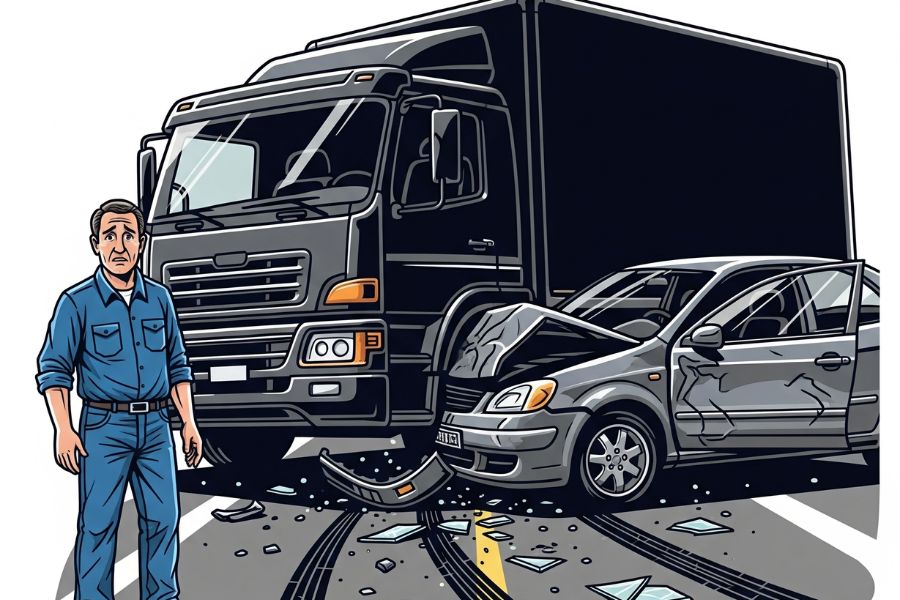Accidents are a sad reality of driving, no matter where you live. Whether you’re a corporate driver or drive for personal reasons, driving safely and responsibly to avoid collisions is the duty of all drivers. That’s why driving programs like low-risk driving courses and corporate driver training courses stress learning to drive safely. However, drivers must also know what to do in case they’re involved in an accident or passing by one. Drivers must know what to do when they’re involved in an accident. And as corporate drivers, knowing the protocols and immediate actions to take is even more important. If you’re ever involved in a car crash as a corporate driver, knowing everything from company protocols to insurance obligations can protect your safety, your job, and your company’s reputation. Here’s what you should do if you are a corporate driver involved in an accident:
1. Ensure Immediate Safety
Safety is always the priority on the roads. So, if you’re involved in a crash, the first thing to do is check if anyone is injured. You should also move your vehicle to the side of the road if possible. This prevents traffic congestion and risks of further harm to other drivers. Another thing to remember is turning on the hazard lights. These lights can warn other road users of a temporary hazard so that they stay alert.
2. Stay Calm and Professional
Accidents can leave even strong men feeling shaken and anxious. However, as a corporate driver, you should stay calm and composed despite the nerves. Corporate drivers represent their companies, and their conduct reflects on the company’s conduct and values. So, they should avoid getting into useless arguments or assigning blame. With proper corporate driver training, they can learn how to be respectful and polite to everyone involved, approaching the crash and its aftermath with a level-headed approach.
3. Call Emergency Services
The next step is to notify emergency services. Some places legally require that accidents be reported to the police, whether minor or major. If your local laws also require reporting, you should inform the police and emergency services of the crash. Emergency personnel are trained to handle these situations. So, when they show up, cooperate fully and follow their instructions properly.
4. Document the Scene Thoroughly
The next step is to properly record and document the scene of the accident. Especially if you’re a corporate driver, you might need these records when filing insurance claims or writing company reports. Take photos of license plates, damage to the vehicle, road conditions, traffic signs and signals, and injuries, if any. Also, collect the contact details, insurance information, and license numbers of all the parties involved. Having all this information can help you later on in the process.
5. Notify Your Supervisor or Fleet Manager
Corporate drivers have to answer to their employers in case of any crashes, and their companies, too, have to be accountable in case of any damage or insurance claims. So, you must inform your supervisor or fleet manager as soon as possible. Many companies have a separate process for reporting accidents. Make sure you are aware of any such processes and follow them when involved in a crash. Reporting early allows the company to act quickly and help you with the treatment and insurance processes. Many corporate driver training services include handling accidents as part of their training.
6. Avoid Admitting Fault
Insurance claims and legal processes after an accident are complex and time-consuming, especially for businesses. That’s why it’s advised that corporate drivers should not admit fault at the scene. Even if you feel responsible, avoid admitting fault. Instead, stick to the facts when talking to authorities and let them decide who is at fault. After hearing all the facts and understanding the situation and events, the authorities and insurers involved will determine liability.
7. File an Insurance Claim with the Right Documentation
Work with your company to file the necessary insurance claim. Provide all documentation—including your written report, photos, witness details, and police report (if applicable). The more thorough your information, the smoother the claim process will be.
8. Understand Your Company’s Policies and Legal Obligations
Every organisation that offers corporate driver training services has its accident response policy. Some may require drug and alcohol testing post-accident, while others may conduct an internal review of the incident. Make sure you’re familiar with these procedures, along with any legal requirements specific to your role or licence.
Be Prepared, Stay Informed
Accidents are stressful, but handling them correctly is a mark of a well-trained professional. By following these steps, you not only protect yourself but also uphold your company’s standards. That’s why ongoing corporate driver training is essential for all business drivers, whether you’re new to the role or experienced behind the wheel. From refining driving habits to understanding accident protocols, every element of a low-risk driving course prepares you to respond with confidence.
If your company hasn’t invested in corporate driver training services, now is the time. Look for reputable trainers like Corporate Driver Training Australia that can give you professional services. Because safe driving isn’t just about avoiding accidents—it’s about knowing what to do when they happen.
also read: Choosing Between a 10×15 Tent Canopy and 10×10 Tent: What Suits Your Event Goals Best?
